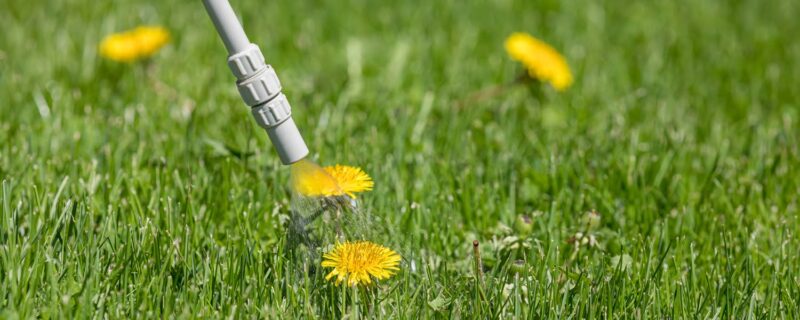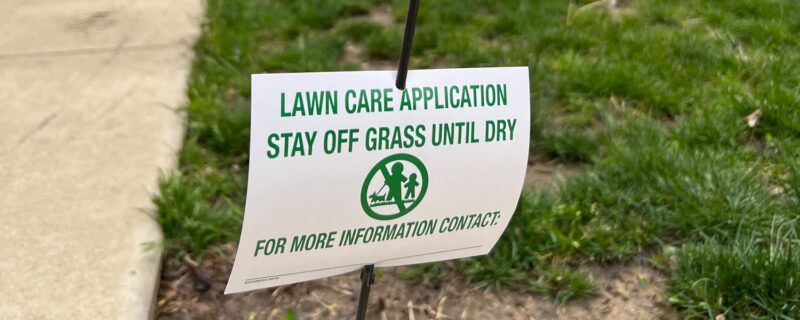
We’ve talked extensively about herbicides drifting off agricultural fields and onto private lands, gardens, and nature preserves.
Today, as communities gear up for Halloween trick or treating, I want to bring attention to another critical concern: chemical lawn treatments. Have you ever stopped to think why they place those little warning flags in yards after spraying? Well, today’s Sunday Scary dives right into that, while also providing you with some alternatives in hopes you can help spread the word.
Let’s be honest: lawns are a little ridiculous. The idea of having a perfectly manicured, sterile patch of green as a status symbol hails from 17th-century European aristocrats who could afford to waste land by not growing anything useful on it. Fast forward to modern times, and we’re still hooked on this outdated concept. But here’s the kicker: achieving that lush, velvety lawn comes at an enormous cost — one that goes far beyond your water bill. We’re talking about millions of pounds of toxic chemicals pumped into the ground to make sure not a single blade of grass dares look out of place.
Chemical lawn treatments are more than just unnecessary — they’re harmful. These herbicides, fungicides, and insecticides contribute to the loss of biodiversity, poisoning not just pests but also beneficial insects, plants, and even pets. Herbicides applied to kill weeds can drift or vaporize, damaging nearby trees and gardens that your municipality — or you — might have spent a pretty penny planting. And let’s not forget the creepy part: your lawn care regimen could be inadvertently killing off fireflies and even tracking hazardous chemicals right into your home.
The fact is, we don’t need endless stretches of grass to show off a well-kept home. What we need are biodiverse, pollinator-friendly landscapes that actually support life.
Each year, approximately 80 million pounds of pesticides are applied to lawns, often at 10 times the intensity per acre compared to agricultural fields. The widespread use of these chemicals for tasks like controlling dandelions or combating grubs and mosquitoes raises significant environmental and public health concerns.
Prairie Rivers Network is actively working to transform lawn care practices to better protect biodiversity, the health of our communities, and change the way we relate to and care for the earth. If you believe in this mission, please consider becoming a member today – even $5 a month helps us better protect biodiversity.
Our report, Hidden in Plain Sight, released this August, uncovered the alarming prevalence of drift in our state, revealing that nearly every site we monitored showed signs of herbicide drift. As a result, trees and plants are becoming less healthy each year due to repeated exposures, and severe decline in tree health and tree death are evident across the state. While agricultural use is the leading cause of drift in our state, many of these injuries can also be traced back to lawn-treatment practices.
Concerns About Creatures
Moreover, the same pesticides that eliminate lawn “pests” are also devastating to bees, birds, fish, and other wildlife crucial to our ecosystem.
The decline of firefly populations — those enchanting creatures that light up our summer nights — is particularly alarming. These insects spend most of their lives in the soil, where their eggs and larvae remain exposed to lawn chemicals for years. Insecticides commonly used in lawn treatments, such as pyrethroids and neonicotinoids, are highly toxic not only to pests but also to beneficial insects like fireflies.
Most people don’t realize that the fertilizer used to make lawns greener is contributing to one of the largest environmental disasters in North America: the Gulf of Mexico’s dead zone. When you over-fertilize your lawn, that excess nitrogen and phosphorus doesn’t just stay put. Rainwater washes it into storm drains, streams, and eventually into larger rivers, all flowing downstream. Once these nutrients hit the Gulf, they trigger massive algae blooms that deplete the water of oxygen, creating a hypoxic “dead zone” where marine life can’t survive. The drive for a perfect lawn is literally choking off life in the Gulf and contributing to algal blooms across Illinois rivers and streams.
Human Health Threats

The alarming truth is that the pesticides we spray on our lawns, playgrounds, parks and ball fields don’t just stay outside where they harm wildlife.
Studies reveal that hazardous lawn pesticides drift or are tracked indoors, exposing us — especially our children — to these toxins. The statistics are staggering: 26 out of the 40 most commonly used lawn pesticides are linked to cancer. Some have been linked to birth defects, liver or kidney damage, and hormonal disruption. As these chemicals seep into groundwater, leach into our drinking water sources, and enter our homes, we must ask ourselves: Are these chemicals worth the risk?
Among the chemicals we detected most frequently in our Tree and Plant Health Monitoring are 2,4-D and dicamba, which are found in popular lawn products that “weed and feed” and are widely used by commercial turf care companies. Both herbicides are linked to human health impacts, especially in people that apply the pesticides. These substances are associated with serious health risks. For instance, dicamba exposure has been linked to an increased risk of liver and bile duct cancers. Furthermore, it is suspected that 2,4-D is linked to increased lymphoma risks and endocrine disruption.
Even more concerning, many chemicals banned for indoor use due to their dangers remain legal for outdoor application. Organophosphates (like malathion) and carbamates (like carbaryl), for example, are still permitted, despite their links to IQ loss and other neurotoxic effects.
The impacts of these chemicals extend to children. Researchers at New York University estimate that more than 160 million IQ points have been lost, and over 700,000 cases of intellectual disability have developed due to exposure to endocrine-disrupting chemicals in recent decades, as highlighted by a 2019 study using data from the Centers for Disease Control and Prevention.
Cancer Risk to Pets

Our beloved pets are also at risk. Research by Dr. Lauren Trepanier, a professor at the University of Wisconsin-Madison, has established connections between herbicide exposure and cancers, such as non-Hodgkin lymphoma and bladder cancer, which are notably prevalent in dogs. Breeds like boxers and beagles are particularly vulnerable. Studies indicate that dogs exposed to herbicide-treated lawns are up to 200% more likely to develop lymphoma. A 2013 study even found that Scottish terriers exposed to these lawns had up to seven times the risk of developing cancer.
Ongoing research by Dr. Trepanier continues to reveal high levels of weed killer in dogs diagnosed with cancer.
What You Can Do

The good news is that alternatives to toxic lawn treatments exist! Here are some steps you can take:
- Eliminate insecticide treatments: Focus on natural pest prevention by mowing higher, watering less, and promoting healthy soil.
- Transition your community spaces: Talk to your park districts, school districts, family and friends to encourage alternatives to chemical lawn treatments.
- Plant a no-mow grass: There are more and more options available for low-growing diverse lawn mixes that are low-maintenance and support pollinators.
- Ditch synthetic fertilizers: Many can be harmful to invertebrates. Instead, consider planting clover or other nitrogen-fixing plants to nourish your soil naturally.
- Avoid spraying for mosquitoes: Eliminate standing water around your home, such as in clogged gutters and refresh birdbaths frequently, to reduce breeding sites.
- Put up a bat box: Natural predators like bats are also extremely helpful! (So are frogs, many birds, and dragonflies!)
- Turn your yard into a habitat: Go with native plants, grab a chair and watch the birds, embrace biodiversity and recognize that some signs of “pest” activity are part of a healthy ecosystem.
Become a Member: We are actively working to implement solutions to pesticide pollution across the state, and we need your support. With a donation today, you are taking a stand against pesticide pollution.
By protecting your yard from pesticides, you’re not only safeguarding your home—you’re creating a sanctuary for pollinators, children, and pets alike. As awareness grows, we can push policymakers to take pesticide safety seriously.
It’s time to rethink our obsession with perfect lawns and make choices that protect people and the planet.
Together, we can cultivate healthier, more resilient communities.







